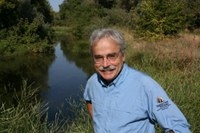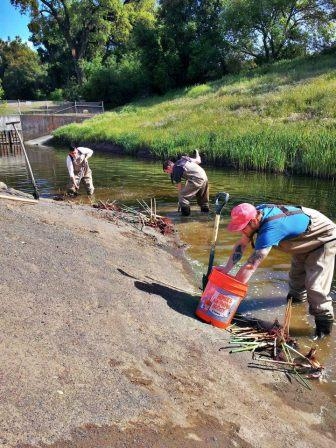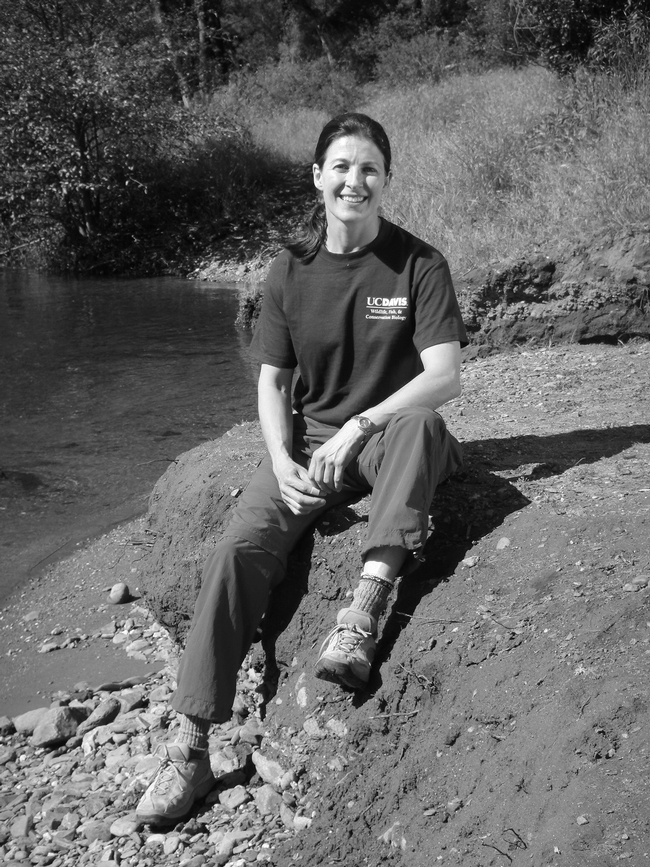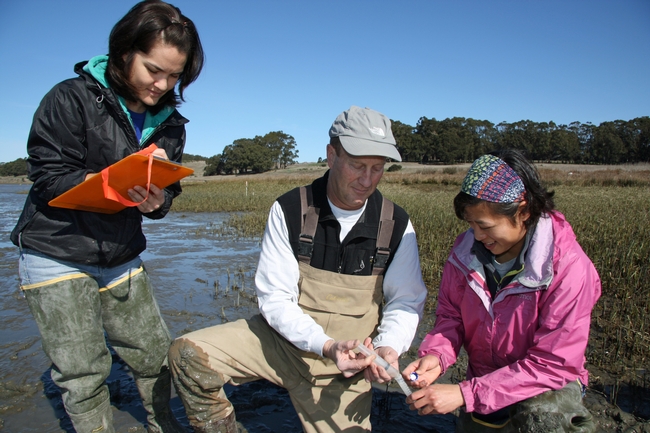Posts Tagged: endangered species
Saving the Mojave desert tortoise
Saving the declining populations of Mojave desert tortoise is a big challenge. But scientists think that raising newborn “hatchling” tortoises in a controlled environment in the Mojave National Preserve for a year, then releasing the juvenile tortoises into the wild, may help save this threatened species.
The protected tortoises — which live up to 80 years and can go without water for a year — have existed for eons, but are now being decimated by habitat loss and predation. Professor Brian Todd, in the Department of Wildlife, Fish and Conservation Biology at UC Davis, worries that the increasing use of Southern California deserts for solar and wind energy, will add to the loss of tortoise habitats, and add further pressure to regional wildlife habitats. While developing renewable energy to combat climate change is a good thing, in this case it impacts desert species and their habitats.

We can all keep our fingers crossed that this research will preserve desert tortoise populations, and serve as a model for conserving biodiversity.
Additional information:
- “Protecting the desert tortoise,” video of UC Davis researchers and desert tortoises.
- “Habitat selection, space use, and factors affecting recruitment of desert tortoises in the Mojave National Preserve”; Brian Todd website, UC Davis
- “Baby desert tortoises get a headstart in the Mojave,” by Andy Fell and Kat Kerlin, Egghead blog, UC Davis. With a video of tortoises and scientists.
 A hatchling Mojave desert tortoise.
A hatchling Mojave desert tortoise. - “Tortoise territory,” by Robin DeRieux, CA&ES Outlook magazine (see pages 2 and 10), UC Davis, spring/summer 2012.
- “Mojave National Preserve celebrates dedication of Ivanpah desert tortoise,” Mojave National Preserve website.

UC Davis scientists share perspectives on endangered species
You don't have to dig too deep into the scientific literature and popular media to find perspectives on threats posed to biodiversity in California and around the globe. Two UC Davis scientists in the Department of Wildlife, Fish and Conservation Biology have published fresh insights into endangered species in recent months.
Endangered Species Act sets a high standard

After passage of the ESA, Moyle and his graduate students initially searched for three species they suspected were in trouble: Modoc sucker, rough sculpin and bull trout. They found the sucker in trouble but easy to protect, the sculpin reasonably secure, and the bull trout near extinction in California. It has since vanished.
"As an untenured professor then, I thought it a bit risky to base a career on finding rare fish," Moyle wrote in an opinion piece published in The Sacramento Bee. “So I also undertook a study of Delta and longfin smelt, which at the time were two of the most abundant fish in the Sacramento–San Joaquin Delta.”
Moyle began a monthly sampling program to keep track of smelt populations and other fish in the Suisun Marsh. A few years later smelt counts dropped dramatically. The data eventually led to the U.S. Fish and Wildlife Service listing the Delta smelt as a “threatened” species under the ESA.
His ongoing research has recorded a statewide decline of most native fishes. With other researchers, Moyle has just completed detailed accounts of the biology and status of more than 60 native fishes — all potential candidates for ESA listings. This study will soon be released by the California Department of Fish and Wildlife.
“Most of our recommendations for preventing extinctions call for more and better water for the fish, or at least for protecting existing water they depend on,” Moyle said. “Funny how it almost always comes down to fish needing water.
“The Endangered Species Act sets a high standard in this regard because it not only forbids extinction; it also mandates recovery of each species to a more sustainable state.”
Moyle's opinion piece can be viewed in its entirety here.
Human longevity an indicator of endangered species

The researchers analyzed data from 100 countries, representing 87 percent of the world's population. They examined 15 social and ecological variables, such as tourism, per capita gross domestic product, water stress and political stability. The study showed that as human life expectancy increases, so does the percentage of invasive and endangered birds and mammals.
“It's not a random pattern,” Lotz said. “Out of all this data, that one factor — human life expectancy — was the determining factor for endangered and invasive birds and mammals.”
New Zealand, the United States and the Philippines had among the highest percentages of endangered and invasive birds. The study has been reported in the Los Angeles Times and other news media. Read more about the study's findings in our news release here. The journal article can be viewed here.
College students create wildlife habitats in a Wild Campus program

Working with campus experts (such as faculty and staff in the Department of Wildlife, Fish and Conservation Biology) and local environmental and conservation organizations, the volunteer students are improving the habitats for local wildlife and engaging the public in hands-on activities.
This is an extraordinary program that gives the students real-world environmental management skills, along with leadership opportunities and communications experience. Professor John Eadie, Department of Wildlife, Fish and Conservation Biology at UC Davis, said of the Wild Campus program, “Hands-on activity is a huge part of the educational experience.”

A past project — Build a Wild Home Day — involved working with the UC Davis Arboretum on a successful public outreach program to build bird and bat boxes for installation on campus. (Great photos of this program are on the group’s Facebook page.)
The Wild Campus organization has a large cadre of eager and dedicated students who are improvising and making the most of limited resources. However, they are in need of donated field equipment (used equipment is fine) and financial contributions.
Visit the Wild Campus website and Facebook page for a feel-good look at what these ambitious students are doing to improve the environment, along with ways you can help them succeed.

Longer human life spans linked to endangered species loss
It's no big surprise that humans are impacting the planet. But a new study pinpoints a sobering connection.
As human life expectancy increases, so does the percentage of invasive and endangered birds and mammals, according to a study by the University of California, Davis.

Human life expectancy, which is rarely included among indexes that examine human impacts on the environment, surfaced as the key predictor of global invasions and extinctions.
“It’s not a random pattern,” said lead author Aaron Lotz, a postdoctoral scholar in the UC Davis Department of Wildlife, Fish and Conservation Biology when the study was conducted. “Out of all this data, that one factor — human life expectancy — was the determining factor for endangered and invasive birds and mammals.”
The study analyzed data from 100 countries, which included roughly 87 percent of the world’s population, 43 percent of global GDP per capita, and covered 74 percent of the Earth’s total land area. Additional factors considered were agricultural intensity, rainfall, pesticide regulation, energy efficiency, wilderness protection, latitude, export-import ratio, undernourishment, adult literacy, female participation in government and total population.
The findings include:
- New Zealand, the United States and the Philippines had among the highest percentages of endangered and invasive birds.
- New Zealand had the highest percentage of all endangered and invasive species combined, largely due to its lack of native terrestrial mammals. The study said that in the past 700 to 800 years since the country was colonized, it has experienced massive invasion by nonindigenous species, resulting in catastrophic biodiversity loss.
- African countries had the lowest percentage of invasive and endangered birds and mammals. These countries have had very little international trade, which limits opportunities for biological invasion.
- As GDP per capita — a standard measure of affluence — increased in a country, so did the percentage of invasive birds and mammals.
- As total biodiversity and total land area increased in a country, so did the percentage of endangered birds. (Biodiversity in this context is not a measure of health but refers to the number of species in an area.)
Lotz said the study’s results indicate the need for a better scientific understanding of the complex interactions among humans and their environment.
“Some studies have this view that there’s wildlife and then there’s us,” said Lotz. “But we’re part of the ecosystem. We need to start relating humans to the environment in our research and not leave them out of the equation. We need to realize we have a direct link to nature.”
The study was featured in the Los Angeles Times, Wired, and the U.K.'s Daily Mail among other media.
UC Davis scientists to discuss aquatic invasive species and research on endangered fish
A pair of leading UC Davis experts will provide a rare glimpse into efforts to protect California biodiversity at a public lecture May 10, 4–6 p.m., in the UC Davis Conference Center.

Their work is featured in the current issue of “CA&ES Outlook,” the magazine of the UC Davis College of Agricultural and Environmental Sciences. The magazine also examines the work of other UC Davis scientists and students working to conserve biodiversity in California.
The event concludes with a reception and an opportunity to visit with Thompson, Grosholz, CA&ES dean Neal Van Alfen, and other participants. The cost is $15 per person. To register, go to https://registration.ucdavis.edu.
For additional information about this event, please contact Carrie Cloud at (530) 204-7500 or crcloud@ucdavis.edu.

